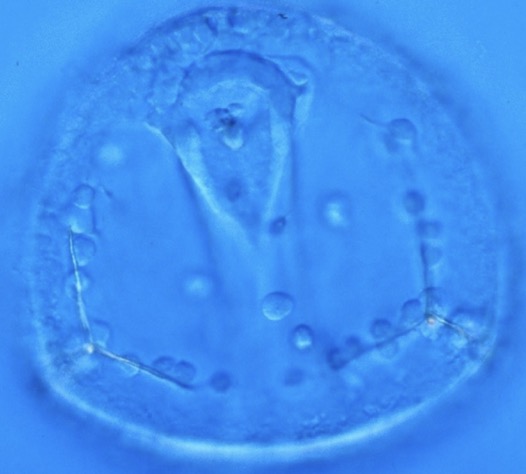Zoo 470 - Introduction to Animal Development
Late L. variegatus gastrula, ventral view. Image by Jeff Hardin, Univ. of Wisconsin
Welcome to Zoology 470!
This site provides basic information about Introduction to Animal Development - Zoo 470. Zoo 470 is a first undergraduate course in animal developmental biology.
Information from the UW-Madison Course Guide
This course introduces students to the major features and mechanisms of early embryonic development in animals, including (1) the major stages of early development, (2) how form arises in the embryo (morphogenesis), (3) how differences arise between cells in the embryo, and (4) how specific genes control these processes.
Requisites: Zool 101 or Zool 151/152
Course Designation: Breadth - Biological Sci. Counts toward the Natural Sci req
Level - Intermediate
L&S Credit - Counts as Liberal Arts and Science credit in L&S
Grad 50% - Counts toward 50% graduate coursework requirement
Basic course information
What’s this course all about?
Zoo 470 is designed to provide an overview of the major features of early embryonic development in animals, and the mechanisms that underlie them. We focus on several major aspects of developmental biology:
(1) How do developmental biologists think about embryos? We'll look at major big ideas in developmental biology, and how they guide modern experimental approaches to studying development. In many cases, classic experiments define the major problems being attacked at the molecular level today.
(2) How do developmental biologists study embryos? We’ll look at molecular and cellular techniques that developmental biologists use, as well as basic properties of cells that we’ll need to know for the rest of the semester.
(3) How do genes control development? We’ll look at how the regulation of specific genes influences the ways in which parts of the embryo become different. We’ll look at how are specific genes are turned “on” and “off” in different parts of an embryo, and why that’s important for building an embryo.
(4) How does an animal embryo arise from a fertilized egg? We’ll look at how sperm and egg are produced, how they unite, and what the consequences are for the onset of embryonic development. We’ll look at how the basic body plan established, and how the basic organization of the embryo arises from the fertilized egg. In addition, we’ll look at the cellular mechanisms underlying morphogenesis, or “body building”. We’ll look at several well-studied invertebrate model systems to help us understand the molecular controls underlying pattern formation, including nematodes and fruit flies. We'll study gastrulation: how the primary axes of the body are constructed.
(5) How are different parts organized properly? We’ll also look at how key structures become patterned in the vertebrate embryo, using the mesoderm, the anterior-posterior axis, and the limb as case studies.
(6) How does developmental biology impact society? Although this is a science course, the science we study has many implications for society. At several points throughout the semester, we’ll stop briefly to examine the knotty problems created by modern developmental biology. At least in one case (stem cells), UW-Madison is at the heart of the controversies. Although what we’ll cover is no substitute for a real course in bioethics, our goal in stopping to think about the greater context in which science takes place is to help us to be better citizen scientists
Why should you take this course?
There are several reasons to take Zoo 470:
(1) Embryos are amazing! Zoo 470 is a great course for students interested in how embryos develop. The main course goal is to give students an appreciation for how amazing embryonic development is. We'll use many videos in class to see just how dynamic embryonic development is.
(2) Stem cells and other biotechnologies at the beginning of life are important: Students interesting in regenerative medicine/biology often take Zoo 470 to provide a solid foundation in basic mechanisms of embryonic development, as well as where stem cells (including embryonic stem cells and induced pluripotent stem cells) comes from.
(3) Development fits well with several other aspects of biology: Zoo 470 is a great complement to other course, including Zoo 570 (Cell Biology), Genetics 466 or 467/468, Zoo 430 (Comparative Anatomy of the Vertebrates) and Zoo 410 (Evolutionary Biology). For neurobiology students, it provides a solid foundation for further study in developmental neurobiology.
(4) The 21st century is the century of biology: Zoo 470 discusses technologies that are going to influence our society in the 21st century, and introduces ways to think about the ethics of embryos. One goal of Z00 470 is to equip students to become better citizens in this key area.
What are the prerequisites?
Because there are few course offerings in biology at the intermediate level, the only official prerequisite for this course is an introductory course in animal biology (Zoo 101/Botany 130, Bio 151/152, or the Biocore curriculum). However, experience has shown that if the only course you have had is Zoo 101 or Bio 151, you must make sure that you have mastered the concepts covered in that course. In particular, the basic concepts of the "central dogma" (how DNA encodes proteins) and the basic concepts of cell structure and function must be well understood for this course to make sense. If you’re unsure about your preparation, please schedule an appointment with us now to get guidance about how to bolster your preparation. An "Intro Bio Jump Start", with a list of suggested reinforcement readings, keyed to Campbell and Reece, Biology, 8 and 9e (Pearson), is on the course web site for those who need a refresher. In addition, there are several excellent introductory biology web sites with synopses of key ideas that are helpful for this course.